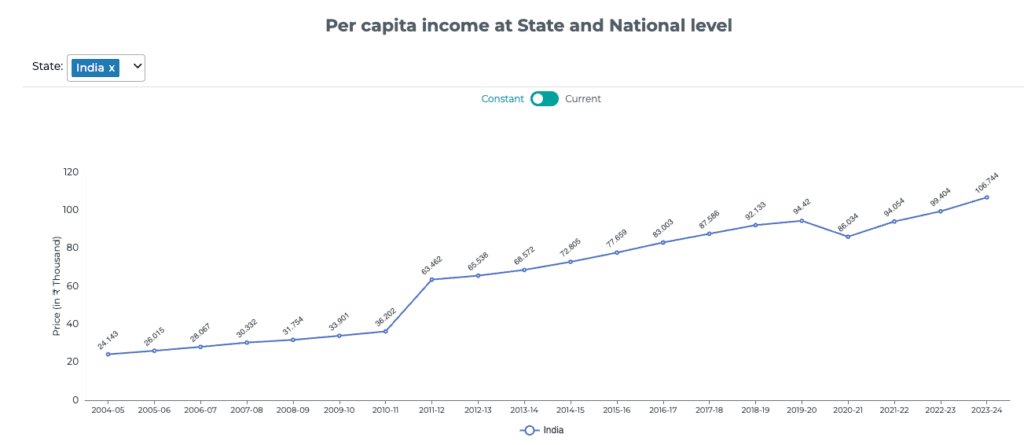Per capita income, commonly known as PCI, serves as a key economic metric that reveals the average income per person in a specific geographic area or country. Additionally, it offers a glimpse into the financial well-being and standard of living of people residing in that region.
By analyzing PCI, policymakers and economists can gain a more effective understanding of income distribution and regional economic health. This blog post will discuss the concept, calculation process, and implications of per capita income to help you learn what is per capita income in detail.
What Exactly is Per Capita Income?
Per capita income refers to the average amount of money each individual in a nation or region earns. This tool gauges the average income of individuals and assesses the quality of life and living standards in that area. When calculating a country’s per capita income, its total income is divided by the population.
India includes every person, regardless of age, in its per capita income calculation as a percentage of the total population, encompassing adults, children, and even newborns. This stands in contrast to other widely used indicators of affluence, such as family income, which considers the income of those related by blood, marriage, or adoption, and household income, which aggregates the wages of all individuals living in the same home.
The Mathematics Behind Per Capita Income
To understand per capita income, consider it a way to measure the average income earned by each individual in a specific region. Therefore, to find the per capita income of an area, divide its total income by the number of people living there. This method for calculating national income considers the average income that each person in the region earns, providing a measurement of economic success on a per-person basis.
Per Capita Income = Total Income of Area / Total Population
To calculate per capita income, divide a region’s total income by its population. This is a significant economic measure that helps determine how much money a typical person in a certain location earns. Besides, the total income and the population number are the two main factors in determining per capita income.
Take a look at this example to see how per capita income is calculated:
Assume that 50,000 people live in a small area, and that area generates a total of ₹50 lakhs. To calculate the income per person, divide the total income (₹50 lakh) by the number of people living in the country (50,000). That means ₹ 50,00,000 ÷ 50,000 = ₹100.
Likewise, you may calculate a nation’s per capita income by dividing its total income by its population. You can gain a better understanding of the typical income of people in that nation by analyzing the per capita income. Therefore, this indicates the people’s standard of living while also reflecting the country’s level of affluence.
Read More: Income from Real Estate Investment Trusts (REITs) and Their Taxation
Crunching the Numbers: Calculating Per Capita Income
When crunching the numbers to understand economic well-being, one key question to ask is: What is per capita income, and how is it calculated to reflect the average earnings of a population? So, let’s find out.
To calculate per capita income, it is essential to know the total income of the entire population and the number of people in that group. To get the Per Capita Income (PCI), you just have to divide the area’s total income by the number of people who live there.
For example, consider a group of five workers employed by a large multinational company. Therefore, based on their job, everyone makes a different amount of money:
· ₹2,500
· ₹3,000
· ₹1,500
· ₹2,000
· ₹1,000
You can see that their incomes are different. Adding up all of their pay and dividing by the number of people in the Group gives you their average income, also known as their per capita income. Hence, the PCI would be ₹2,000 in this case.
Applying the Formula:
· Total Income of the Group = ₹10,000
· Population Size = 5
· Per Capita Income = ₹10,000 ÷ 5 = ₹2,000
Let’s modify the scenario: suppose there are 10 people in total, but only five of them are working and earning a total of ₹10,000.
· Total Income of the Population = ₹10,000
· Size of the Population = 10
· Per Capita Income = ₹10,000 ÷ 10 = ₹1,000
It is essential to include every member of the population when computing the per capita income, regardless of whether they are working or not, as shown in this modified example. Moreover, it reveals the average earnings of each person, offering a more comprehensive view of the country’s economic health.
Read More: Who is a SEBI Registered Investment Advisor?
Per Capita Income At the National Level

Importance of Per Capita Income
After understanding what is per capita income, let’s discuss its importance. A key indicator of economic development, per capita income influences both individual and community quality of life and informs governmental choices.
· Economic Well-Being Measure: Per capita income provides insights into a population’s economic well-being by measuring the amount of money accessible to each individual.
· Comparative Evaluation: This approach simplifies the identification of economic patterns. Besides, it also enhances the assessment of policy efficacy through comparisons across nations or regions.
· Quality of Life: Higher per capita income is linked to improved living standards. This is because individuals can purchase more goods, services, healthcare, and education if they earn a higher income.
· Wealth Management Tool: Per capita income measures a nation’s economic performance and plays a crucial role in managing wealth.
· Early Warning System: Leaders respond to declines in per capita income by evaluating economic policies. They identify issues and create strategies to address downturns.
Limitations of Per Capita Income
A popular metric for evaluating a population’s economic health is per capita income. But what is per capita income? It refers to the average income per person in a region. While it provides a general idea of typical income levels, it has some flaws that can make it less accurate and less valuable. Some of the key drawbacks include:
· Inequality in Earnings: For many individuals, per capita income may obscure the true quality of life. This measure fails to account for income distribution disparities within a community.
· Inflation: Per capita income might give an inflated view of actual buying power. It fails to account for inflation, particularly in countries where prices have risen substantially over time.
· Personal Wealth Exclusion: Per capita income offers a limited view of individual wealth. It focuses solely on earned income, neglecting personal savings and asset accumulation.
· Non-Earning Population Inclusion: In regions with elevated birth rates, including children and other non-earning individuals, the per capita income calculation can skew the results, leading to misleading conclusions regarding the overall state of the economy.
Smarter Planning with Per Capita Income
Per capita income helps companies make better investment, policy, and growth decisions. It is most useful when paired with inflation rates to measure actual trends in income. Businesses can uncover market saturation trends and spending habits by tracking growing income areas on an annual basis. Per capita income is beneficial, but its actual worth derives from how it guides actions and plans.
Conclusion
Per Capita Income shows how much money each person in a particular area makes on average. If you’re wondering what is per capita income, it’s simply the total income of a population divided by the number of people, giving an average yearly income per person. It only reflects income earned in a year, not the total wealth an individual possesses.
In essence, it is just the measure of a population’s total income relative to its size. It is one of the most effective ways to gauge how well people are living. The concept and calculation of per capita income are relatively simple, but they are powerful tools that can reveal a great deal about a population’s financial well-being.
FAQs
1. What is per capita income, and how is it calculated?
Per capita income refers to the average income earned by each individual in a specific region over a specified period. The formula for determining it is to divide the total income of that region by its entire population. This answers the question, what is per capita income.
2. What does per capita income indicate?
Studying a region’s per capita income can help you determine its average level of economic prosperity and living standards. This represents the average amount of money each individual earns. Although helpful for comparing different countries, it ignores wealth distribution among the population, cost of living, and income inequality.








